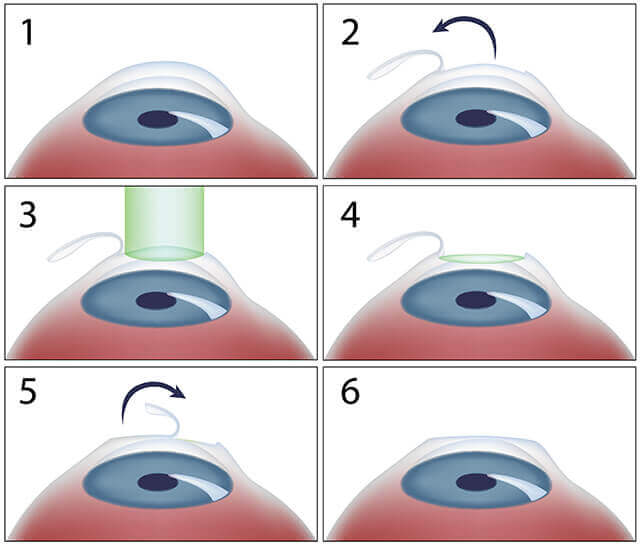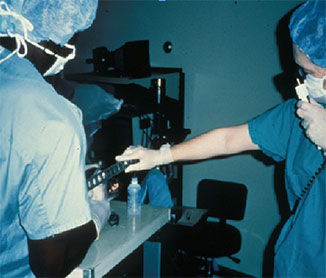
LASIK Eye Surgery in Athol, MA & Beyond!
A vision correction option that can enable clear vision and 20 years of successful patient outcomes.
Have you ever considered LASIK eye surgery to correct your vision? If you are looking for a LASIK surgeon near you, The Eye Center offers LASIK consultations to help you determine if you would be a candidate for this type of eye surgery. The only way to truly determine your candidacy for LASIK would be to schedule a LASIK pre-operative evaluation at one of our convenient locations in the Greenfield and Athol, MA area. Millions of people have enjoyed the benefits LASIK has brought them and often wish they had done it sooner.
What are the benefits of LASIK or Laser Vision Correction?
Imagine being able to have a lifestyle with reduced dependence on glasses or even completely glasses free. Can you imagine swimming, skiing or playing sports without the aggravation of glasses or contact lenses? Aside from lifestyle benefits your vision will LASIK will enable you to function in life better by seeing the alarm clock at night or seeing extreme detail in your daily routine.
5 Top Benefits of LASIK Eye Surgery
- Improved vision often without the need for glasses or contact lenses.
- Immediate results often within a day of surgery.
- Active lifestyle enhancements enabling a wide range of sports and outdoor activities.
- No more hassles of glasses and contact lenses.
- Most patients report no pain at all during LASIK surgery.
What is the Cost of LASIK?
The cost of LASIK varies depending on several factors including overall quality, the experience of the surgeon, types of technology used and amount of patient care both pre and post operatively.
LASIK is also covered by Flex Spending Accounts. Call us and consult with our laser vision staff to discuss how your Flex Spending Account can reduce the total cost of a LASIK eye surgery.
Modern LASIK at The Eye Center is a painless, vision correction procedure that takes less than 20 minutes to complete. In most cases, patients can resume normal activities the next day after LASIK.
How is LASIK Eye Surgery Done?
LASIK Eye Surgery is performed with lasers and works by changing the shape of the cornea. This alteration helps to change the way images are focused on the retina. The process is done in minutes and involves two significant steps.
- A Laser creates a tiny flap on the surface of the eye; it is then gently pulled back to reveal access to the cornea
- An excimer laser gently changes the cornea’s shape, and the flap is gently put back into place.
This procedure usually allows people to return to work the next day.

LASIK Eye Surgery reviews
Please feel free to take a moment to review some of our LASIK review on Google. We aim to provide an amazing patient experience and feel that is widely recognized in these reviews.
I have never felt more comfortable going into a procedure like this than I did with the doctors and surgeon I worked with at the Eye Center. They were kind and explained everything that was going on every step of the way. Even the techs helping out were pleasant and explained what they were doing! They prepared me for everything I experienced before going in. Now because of all of their help, I have 20/15 vision the following day! I can’t thank them enough! I highly recommend them to anyone interested in getting LASIK!
You have decided LASIK is a good option. What are the next steps?
Step 1:
Schedule your consultation.
Step 2:
Determine your candidacy with a pre-op evaluation.
Step 3:
Correct your vision with laser vision correction.
How Can I Prepare for LASIK Eye Surgery?
- Wear Your Glasses. Bring your most current pair of glasses with you. Should you wear contact lenses to your appointment, please bring your contact lens case, as you will be asked to remove them.
- 1-Hour Visit. Plan on being at our office for approximately one hour.
- Bring Your Calendar. You may find it helpful to bring your appointment calendar with you for convenient scheduling.
What are LASIK Results Like?
At the Eye Center, we provide personalized outcomes assessments. Whatever your level of myopia, hyperopia, or astigmatism, we’ll provide you with specific information about your likelihood of achieving 20/20 vision or better following your LASIK eye surgery. No guessing. No generalities. Just the facts!
Laser vision correction results in a permanent change to the shape of the cornea and the way the eye focuses light. Laser vision correction will not prevent age-related conditions such as presbyopia (the need for reading glasses) or cataracts. These conditions would still be treated in their normal manner.
What is Recovery Like Following LASIK Eye Surgery?
Many patients get up from the surgical chair and already start to see the clock on the wall. Most patients notice dramatic improvement within the first few days following the procedure and are able to drive a car and return to work within one to three days. Generally speaking, most LASIK patients see quite well the next day. However, the speed of visual recovery ultimately depends on personal healing patterns. After LASIK, restriction on activities is minimal. Our LASIK eye surgery counselors will review all of the after LASIK care that you will want to understand to ensure safe healing.
Major Advancements in LASIK Technology
Keratomileusis, brainchild of Jose I. Barraquer Moner, was conceived and developed as the first stromal sculpting method to correct refractive error in 1948. The word “keratomileusis” literally means “sculpting” of the “cornea.” Barraquer’s first procedures involved freezing a disc of anterior corneal tissue before removing stromal tissue with a lathe. Source: National Institutes of Health
The First Laser Vision Correction Procedure (1988)

The first laser vision correction procedure took place in 1988, when a 60-year old woman with a serious vision problem allowed surgeon Marguerite McDonald to perform the first photorefractive keratectomy (PRK) procedure on her damaged eye. Source TLC
Dr. Gholam A. Peyman, a retina surgeon and ophthalmologist, invented LASIK (laser-assisted in-situ keratomileusis). In 1989, he was awarded the first patent in the United States for this procedure. Source: NVision
1995-2000 – The advent of the first excimer lasers used in conjunction with microkeratome on several patients. This was a blade driven system that required a mechanical blade to make the corneal flap.
- PRK FDA approval occurred in 1995
- LASIK FDA approval occurred in 1996
2000-2003 – Wavefront technology is approved in May of 2003. Using a wavefront device, your eye surgeon can measure your distinct cornea’s shape and texture, and then customize the laser to treat your unique eyes.
Additional work in LASIK vision correction has been directed at improving procedure customization to achieve correction of both refractive error and higher-order aberrations, aiming for the goal of improving day and night quality of vision, and achieving vision beyond 20/20 for most patients.
